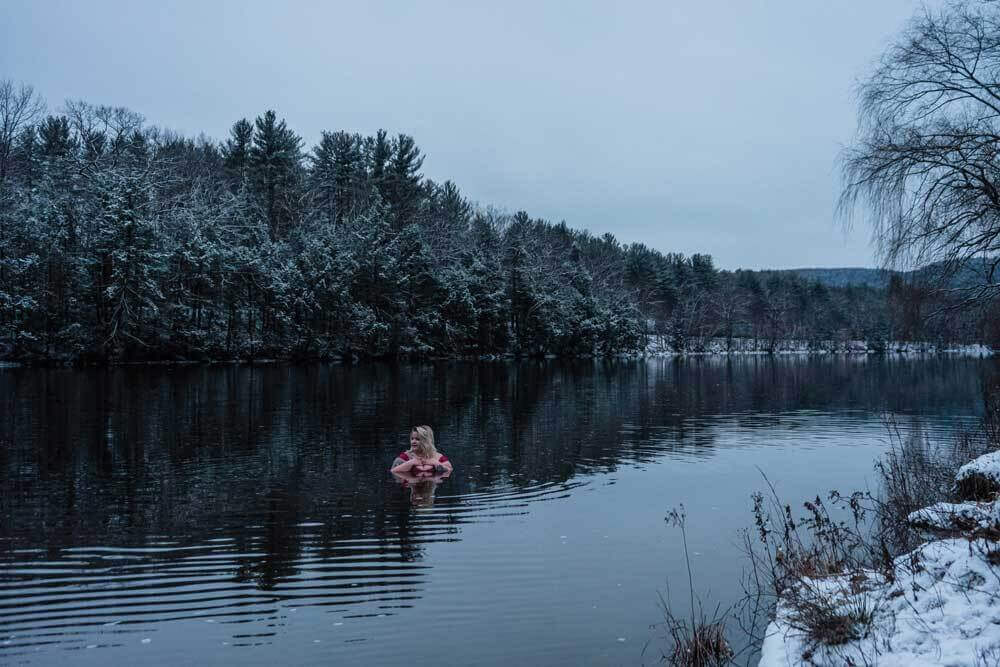Carin Teresa swims away the pain
It’s before sunrise on winter solstice and I’m standing in a red swimsuit and neoprene booties, wearing a crown of cedar branches. I’m on the shores of the Puget Sound with a group of women that I get in the water with weekly. Several of us have brought candles to bring light to the dark morning. There are some shouts as we enter the water, some sounds of deep breathing. But mostly there’s laughter. Joy.
Lately there’s been an increasing interest in getting into cold water. The proliferation of frigid polar bear plunges (like the famous Coney Island, NY event every New Year’s Day) and organizations like the Outdoor Swimming Society (outdoorswimmingsociety.com) have helped popularize the practice. Around the country, small groups of friends are gathering at the shores of bays, lakes, and rivers to submerge themselves, not simply braving the kind of waters that make a pool feel like a hot tub, but relishing them.
 Photo: @ebb.and.flow.collective / Tricia Capello
Photo: @ebb.and.flow.collective / Tricia Capello
We all come to the cold water for different reasons, but talk to enough cold-water swimmers and dippers and you’ll hear about the plentiful mental health benefits – of boosted moods, being more patient, finding clarity, and feeling resilient. “The cold water is a teacher for me. A teacher of presence, of courage and bravery, of getting to calm even under stress,” says Libby DeLana, the author of Do Walk: Navigate, Earth, Mind, and Body. Step by Step. Getting into a body of cold water is, after all, incredibly physical. You feel it on your skin and in your bones. Your arms and legs turn bright red, chilled, and prickly. But cold-water swimming is as much a mental practice as it is a physical one, and it creates a place where the two are inextricably linked.
Carin Teresa, also known by her Instagram handle @swimawaythepain, suffered various traumas and abuse from an early age, and her psychological wounds have manifested in physical ways, like chronic pain, including fibromyalgia. Cold water has become an essential salve. “In the ice, there is some silent switch in my brain that gets flicked. I feel my power, my blood, my fire, my strength surge through my veins,” she says. “I am able to think of something other than pain. At the beginning even the tiny thoughts about the sparkle of ice in the sun or the sound of water trickling over rock, ice, and stone felt revolutionary.”
Teresa is not alone. “Cold water is the only place where everything is beautiful and nothing hurts,” says Kerri Anne Stebbins, whose chronic pain and recurring injuries left her unable to move her body in the ways she was used to. The artist and cofounder of McCall Made in McCall, ID, swims daily in local Payette Lake until it freezes around mid-December. “Cold water has given me a place to move freely and joyfully,” she says. That sense of joy resonates with many of us who get in cold water – like a runner’s high on overdrive. “Someone asked me recently, ‘What is it like to walk into the cold water?’” says DeLana. “I responded, ‘It feels like falling in love.’ The rush of excitement, the thrill, the dopamine. It feels like falling in love.”
As Bonnie Tsui writes in her book, Why We Swim, “Three decades of swimming, of chasing equilibrium, have kept my head firmly above water. Swimming can enable survival in ways beyond the physical.” That feeling can be amplified in the cold, and even just a dip in the height of winter is enough to put you in that place. Walk into the water and instantly your body wants to resist. It shouts, “Get out of here immediately!” Instead, you breathe, you give in to the cold. Teresa describes it as a “delicious presence.” In the water, you work through the darkness instead of against it. And when we realize what we’re capable of? When we feel that moment of presence where everything else falls away? It’s as if, in that moment, we have found our true sense of self.
Is the Cold Water Calling You? Here Are a Few Tips To Get You Started
Go With a Friend
Safety is essential in the cold water, so it’s important that you go with a friend, even if they’re just on land keeping an eye on you. Cold-water swimming is an excellent social activity anyway, so all the more reason to get someone else hooked on the practice with you.
Start Slow and Breathe
Don’t dive or jump; ease your way into the water so that your body gradually adapts. As you enter the water, focus on your breathing. See if you can slow it down to help calm your mind and body.
Work Your Way Up
To get the benefits of cold-water immersion, you don’t need long periods of time in the water. Start small (even just a minute or two) and build up your resilience slowly.
Know the Conditions
It’s important to be mindful of the conditions when you get in the water. Is it windy? Is the water choppy? What’s the air temperature? All of these things impact a swim and may make you choose not to get in the water that day.
Trust Yourself
The most important thing about cold-water swimming is to listen to your body and trust your intuition. If you’re not feeling it that day, don’t go in. There’s always tomorrow!
– Anna Brones
Top Photo: Courtesy of Carin Teresa
This article originally appeared in BUST’s Winter 2022-2023 print edition. Subscribe today!


